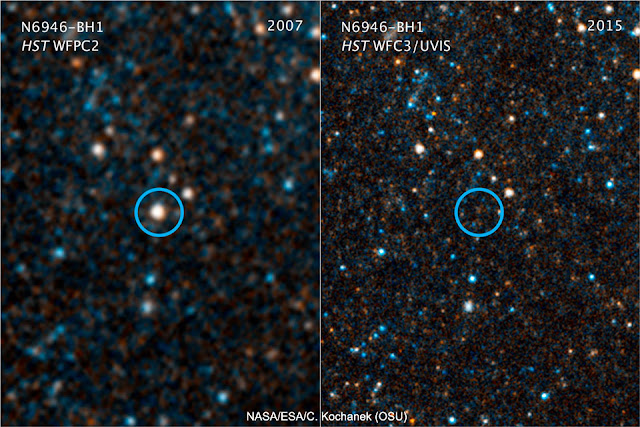Astronomia, astrofísica, astrogeologia, astrobiologia, astrogeografia. O macro Universo em geral, deixando de lado os assuntos mundanos. Um olhar para o sublime Universo que existe além da Terra e transcende nossas brevíssimas vidas. Astronomy astrophysics, astrogeology, astrobiology, astrogeography. The macro Universe in general, putting aside mundane subjects. A look at the sublime Universe that exists beyond Earth and transcends our rather brief life spans.
Pesquisar conteúdo deste blog
sábado, 10 de junho de 2017
The Case of the Missing Star | O caso da estrela desaparecida
O que aconteceu com a estrela gigante N6946-BH1? Ela estava lá há poucos anos — o Hubble a fotografou. Agora, há apenas um brilho esmaecido. O que é mais curioso é que não houve nenhum brilho de explosão de supernova — embora a estrela tenha tido seu brilho aumentado bastante durante alguns meses.
A teoria reinante é a de que , com cerca de 25 vezes a massa do Sol, a forte gravidade deN6946-BH1 manteve boa parte da estrela unida durante seus tumultuados estertores finais, após os quais a maior parte dela caiu num buraco negro formado por ela mesma.
Se tiver sido assim, então o que restou fora do buraco negro formou então, provavelmente, um disco de acreção que emite luz infravermelha comparativamente fraca, enquanto gira, antes de cair lá dentro.
Caso esse tipo de morte estelar seja confirmado em relação a outras estrelas, isso fornecerá provas diretas de que uma estrela de muito grande massa pode encerrar sua existência com um murmúrio, em vez de uma explosão.
Tradução de Luiz M. Leitão da Cunha
What's happened to giant star N6946-BH1? It was there just a few years ago -- Hubble imaged it. Now there's only a faint glow. What's curiouser, no bright supernova occurred -- although the star did brightened significantly for a few months.
The leading theory is that, at about 25 times the mass of our Sun, N6946-BH1's great gravity held much of the star together during its final tumultuous death throes, after which most the star sunk into a black hole of its own making.
If so, then what remained outside of the black hole likely then formed an accretion disk that emits comparatively faint infrared light as it swirls around, before falling in.
If this mode of star death is confirmed with other stars, it gives direct evidence that a very massive star can end its life with a whimper rather than a bang.
Assinar:
Postar comentários (Atom)

Nenhum comentário:
Postar um comentário